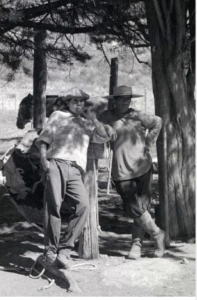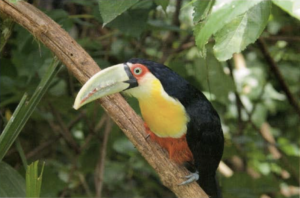CNN Traveller, March / April 2011
The provinces of Corrientes and Misiones in northern Argentina have more in common with their sub-tropical neighbours than with Eurocentric Buenos Aires. Ed Stocker journeys into a wildlife paradise.
The distance from Argentina’s capital. Buenos Aires, to the northern state of Corrientes is admittedly huge. But the nearly 1,000km trip is more than an epic journey – it’s like travelling to a different world.Corrientes is where Argentina surrenders to the sub-tropics, where the earth is a bright orange hue and grassy wetlands that look like they belong to southern Africa stretch on and on. At the farthest reaches of the province, the Paraná, one of the world’s great rivers widens into a watery frontier with Paraguay.You know you’re somewhere different when the names of the local animal population are impossible to pronounce. The yacaré is a breed of caiman that grows up to three metres in length. It’s harmless unless provoked but looks fierce nonetheless. It’s found in the murky waters of Corrientes and across the border in Paraguay and the southern states of Brazil.
There would be plenty of opportunities over the next few days to see the beast up close and personal. And maybe, just maybe, the aguará guazu, an endangered maned wolf.
The plan is to visit Corrientes before heading northwards into Misiones, a state that juts out like a jagged rock face between Paraguay and Brazil. The two states, while attracting tourists, are nowhere the big ticket destinations of Patagonia, Mendoza and Salta. People head en masse for Iguazú Falls in Misiones but either head straight back to Buenos Airesa or northwards into Brazil, generally without exploring the thick rainforest that is a hallmark of the area.
Corrientes, too, is an impressive combination of fertile farmland, flat plains, flooded wetlands and vast yerba mateplantations – the plant used to make mate tea, the ubiquitous Argentine drink sipped out of a gourd through a metal straw known as a bambilla.
Buenos Aires province is famed as the birthplace of the gaucho, the legendary South American cowboy who had his heyday in the 19th century, working on the estancia during the day and then heading off to the bar every night to love, laugh and fight – not necessarily in that order.
Yet arriving in the Corrientes town of Mercedes as dawn is breaking feels far more authentic than anything Buenos Aires has to offer, despite what the guidebooks might say. Crumbling turn-of-the-century buildings frame small squares and rugged locals sporting boinas (berets) – a fashion accessory all adult men seem to wear – lean on battered pick-up trucks sipping, yes you guessed it, mate.
Hostería Rincón del Socorro is located an hour’s drive in a 4X4 from Mercedes, near the town of Carlos Pellegrini. It’s a breathtaking position right on the edge of the Esteros de Iberá, a vast area of wetlands for which the region is famous. As some indication of its size, it’s about two and a half times bigger than the Florida Everglades. The hotel is owned by American entrepreneur and founder of the North Face clothing company, Douglas Tompkins.
As the car pulls into the hotel drive, several grey rheas known locally as ñandú, strut around the lawn. They look like well-groomed, domesticated birds, brought in to add a touch of class to surroundings. My driver, Fermin, explains that they are in reality completely wild – because the hotel is so near to the wetlands they simply wander in when they feel like it.
Moments later, a trio of giant furry brown creatures, rigid on the grass as if they’re playing a game of musical statues, comes into view, completely oblivious to us. They are carpinchos (capybaras), the iconic animal of the Esteros that look like giant guinea pigs, and they waddle back towards the surrounding vegetation as we pass, their ample bottoms swinging behind them.
Tompkins has turned his attention to philanthropic activities in recent years, making it his mission to restore endangered ecosystems in many of the world’s remotest spots. In fact, the hotel is almost a side project – set within 31,000 hectares of wetlands and woods – to the real business of conservation.
Tompkins has set up an NGO called Conservation Land Trust (CLT), which has started to reintroduce endangered and locally extinct species, including anteaters and deer. I ask employee Carinea Grandoli what their overall goal is.
“In the long term the aim is to return the purchased land to the states they belong to so that they can be incorporated into the state-run protected areas,” she says. “We’ve already donated land on two occasions: the current national parks in Monte León in Argentina and Corcovado in Chile.”
One of the highlights of staying at the hotel – where wildlife wanders around without a care in the world – is going on a night safari with amiable guide Leslie Cook who, despite a name that seemed to suggest otherwise, is Argentine through and through. A Correntino of Scottish descent, his job is to man the clapped-out Land Rover and light up the pampas grass surrounding the roadside with a powerful torch. The chances of seeing giant storks or foxes viciously tearing apart the carcass of a capybara are pretty high.
No stay at Rincón del Socorro would be complete without taking a boat out to the Laguna de Iberá. What makes this flat, extraordinary landscape so good for spotting birds and animals is the lack of tall trees blocking the horizon.
Weaving between narrow inlets of palm trees and purple and yellow flowers, we cruise through the lagoon (Iberá means shimmering water in the indigenous Guarani language) full of birds, yacaré keeping perfectly still to maintain their body temperature and hundreds of different birds, including the red-crested federal.
We get the chance to see the yacarés in very different surroundings at Puerto Valle, northern Corrientes, not far from the frontier with Misiones. The hotel runs a farm next to the main complex and it’s full of caimans of all shapes and sizes. The farm raises these animals for their skin and sells the leather to Europe, where it’s made into everything from handbags to boots. But, keen to ensure the local habitat isn’t affected, the farm reintroduces a percentage of the reptiles into the wild so that natural stocks are not significantly depleted.
Corrientes is one of Argentina’s bread-baskets and a major source of much of its agricultural wealth. Sadly, a lot of the rainforest has been cleared to make way for farm plots. For the true jungle experience, Misiones is the place to head to. Up to 10,000 visitors a day flock to the billowing waters of Iguazú Falls but they miss out on the rest of the province. Even porteños – with their trendy clothes and European ways – look out of place here, an area of Argentina that has more in common with its northern neighbours than the capital.
About half an hour’s drive south of the Falls, in the middle of the rainforest , is the Posada Puerto Bemberg. It’s a wonderfully tranquil setting: toucans flutter outside the wooden decking area where tables are set up for breakfast, showing off their colourful crests; in the gardens nearby every conceivable type of tropical fruit and vegetable is grown for the kitchen.
The enthusiastic caretaker, Roberto, points out a potato-like plant that grows on trees and is used by the Guaranípeople to treat medical ailments.
The indigenous Guaraní population of around 20,000 remain marginalised, their lives complicated by legislation that stops them living off the land, forcing them to rely on hand-outs and cash to buy food.
Living in poverty on the fringes of society, they speak their own language and keep largely to themselves.
The community of Fortin Mbororé opened its doors to tourism around 10 years ago. At first, some of the elders objected but they’ve grown to accept it as an important source of income.
On our visit Robert shows us round and we are present to the chief, Silvino. Roberto himself cannot read or write, because he never went to school. But thanks to the money from tourism, he can afford to send his children.
Would he change the way things had worked out?
“All I really want,” he says slowly, “is for people around the world to care about nature and look after the environment.” After spending time in Argentina’s northeast, it’s easy to see why.

